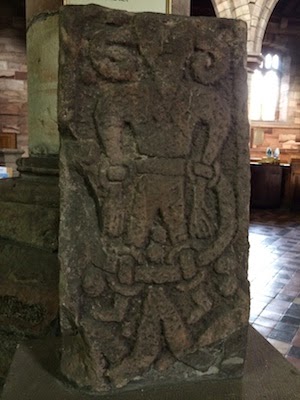 |
| England’s Loki Stone |
If you’ve watched a few superhero movies lately, you know that Loki is a figure from Norse Mythology. That he was Thor’s brother is creative license on Marvel’s part, not taken from the mythology that also features magical hammers and Odin and valkyries and runes and inspiration for the likes of Wagner (the composer) and Tolkien (“The Hobbit” and “The Lord of the Rings”).
Unlike the really bad guy in the movie, the Norse Loki was more of a mischief-maker. He was the god who “stirred stuff up” and made people do stupid, bad things.
So we were pretty surprised when we stepped into the Parish Church of Kirkby Stephen (a wonderful example of a grand, old English village medieval church, by the way, that we’ll blog about in a couple of days) and walked right up to the “Loki Stone” shown above. This 10th century Anglo-Danish stone carving is the shaft of a cross bearing the image of a horned, chained devil. In the Christian sense, it’s meant to represent the binding and subduing of evil.
The image borrows the earlier Norse traditional representations of Loki, portraying the Norse god of mischief as Satan, likely because Loki’s role in Norse mythology is similar–inciting mankind to do bad stuff–to that of Satan in Judeo-Christian tradition. Northern Europeans, converted to Christianity, simply continued to depict their characters in the same contexts and using the same imagery, and Danish and viking raiders brought those artistic concepts with them to Britain.
There are only two examples of “Loki Stones” known to exist in Europe, including this one in Kirkby Stephen, England.






